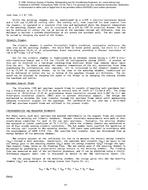Description
Thermal resistance measurements of two highly insulated residential walls are made using a calibrated hot box operated under winter and summer climatic conditions. The well-insulated wall consists of two insulated wood-frame sections with staggered framing, having a nominal thermal resistance of R-27 h•ft2F/Btu (4.8 m2 K/W). The superinsulated wall is identical in construction, except for additional insulation placed between the two wood-frame sections increasing the wall thermal resistance to a nominal value of R-39 h•ft2 F/Btu (6.9 m2 K/W).
The measured thermal resistance for both walls is examined as a function of mean wall temperature and compared with predictions using the ASHRAE parallel-path method, the ASHRAE isothermal-plane method, and a finite-difference model with temperature-dependent thermal conductivities. Good agreement between measured and predicted values is obtained using both ASHRAE methods and the finite-difference model. At mean wall temperatures above 40 F (4.4°C), the ASHRAE parallel-path method tends to overpredict, while the ASHRAE isothermal-plane method tends to underpredict the overall thermal resistance. The effects of the compression of glassfiber blanket insulation and nail penetrations on the overall thermal resistance are investigated.
Units: Dual
Citation: Symposium, ASHRAE Transactions, 1986, vol. 92, pt. 2B, Portland, OR
Product Details
- Published:
- 1986
- Number of Pages:
- 16
- File Size:
- 1 file , 1.4 MB
- Product Code(s):
- D-PO-86-12-6




